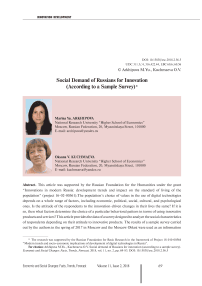Social demand of Russians for innovation (according to a sample survey)
Автор: Arkhipova Marina Yu., Kuchmaeva Oksana V.
Журнал: Economic and Social Changes: Facts, Trends, Forecast @volnc-esc-en
Рубрика: Innovation development
Статья в выпуске: 2 (56) т.11, 2018 года.
Бесплатный доступ
This article was supported by the Russian Foundation for the Humanities under the grant “Innovations in modern Russia: development trends and impact on the standard of living of the population” (project 16-02-00561).The population’s choice of values in the use of digital technologies depends on a whole range of factors, including economic, political, social, cultural, and psychological ones. Is the attitude of the respondents to the innovation-driven changes in their lives the same? If it is so, then what factors determine the choice of a particular behavioral pattern in terms of using innovative products and services? This article provides the data of a survey designed to analyze the social characteristics of respondents depending on their attitude to innovative products. The results of a sample survey carried out by the authors in the spring of 2017 in Moscow and the Moscow Oblast were used as an information basis. The surveyed sample comprised 1,115 individuals aged 15 to 86 years, including 55.5% of women and 44.5% of men, which generally corresponds to the age and gender structure of the population in the regions surveyed...
Innovation, society development, social demand, population survey, classification tree, innovative behavior
Короткий адрес: https://sciup.org/147224046
IDR: 147224046 | DOI: 10.15838/esc.2018.2.56.5
Список литературы Social demand of Russians for innovation (according to a sample survey)
- Cajaiba-Santana G. Social innovation: moving the field forward. A conceptual framework. Technological Forecasting and Social Change, 2014, vol. 82, pr. 42-51.
- Dawson P., Daniel L. Understanding social innovation: a provisional framework. International Journal of Technology Management, 2010, no 51 (1), pp. 9-12. Available at: http://www.inderscience.com/info/inarticle.php?artid=33125.
- Abdrakhmanova G.I., Kovaleva G.G., Kotsemir M.N. Russia in the ICT development rating. Informatsionnyi byulleten’=Newsletter, 2016, no. 2 (7)..
- Arkhipova M.Yu., Khavanskov V.A. Informational-statistical monitoring of inventive activity of RAS on the basis of patent information resources. Ekonomicheskaya nauka sovremennoi Rossii=Economics of Contemporary Russia, 2012, no. 2 (57), pp. 117-129..
- Minochkin A.L. Digital divide in the modern political system: the nature and essence. Vestnik Saratovskogo gosudarstvennogo sotsial’no-ekonomicheskogo universiteta=Vestnik of Saratov State Socio-Economic University, 2013, no. 3, pp. 27-35..
- Mačiulytė-Šniukienė A., Gaile-Sarkane E. Impact of information and telecommunication technologies development on labour productivity. Social and Behavioral Sciences, 2013, vol. 110, pp. 1271-1282.
- Atkinson R.D., Castro D.D. Digital Quality of Life: Understanding the Personal and Social Benefits of the Information Technology Revolution. 2008.
- Shaposhnik S.B. Human capital as a factor of the information society development in the CIS countries. Informatsionnoe obshchestvo=Information Society, 2016, no. 4-5, pp. 72-80..
- Gokhberg L.M. (Ed.). Gracheva G.A., Kuznetsova T.E., Rud’ V.A., Suslov A.B. Innovatsionnoe povedenie rossiiskikh predpriyatii . Moscow: NIU VShE, 2012.
- Cohen A.J. Innovation and economic growth. Available at: http://www.progressivepolicy.org/.
- Aivazyan S.A. Analiz kachestva i obraza zhizni naseleniya. Ekonometricheskii podkhod . Moscow: Nauka, 2012. 432 p.
- Kossov V.V. Dynamics of the quality of life in constituent entities of the Russian Federation and the focus of social policy. Mir Rossii=Universe of Russia, 2001, no. 2..
- Rimashevskaya N.M. Health of the Russian population in the conditions of socio-economic modernization. Narodonaselenie=Population, 2015, no. 4, pp. 33-42..
- Rimashevskaya N.M. Gendernye stereotipy v menyayushchemsya obshchestve: opyt kompleksnogo sotsial’nogo issledovaniya . Moscow: Nauka, 2009. 273 p.
- Yakovets T.Yu. Demographic problems of forecasting and modeling of global sustainable development. Partnerstvo tsivilizatsi=Partnership of Civilizations, 2013, no. 3, pp. 220-225..
- Greenstone M., Looney A. A Dozen Economic Facts about Innovation. POLICY MEMO. 2011. Available at:: https://www.brookings.edu/wp-content/uploads/2016/06/08_innovation_greenstone_looney.pdf
- Lichtenberg F.R. Pharmaceutical Innovation and Longevity Growth in 30 Developing and High-income Countries, 2000-2009. NBER Working Papers 18235, National Bureau of Economic Research, Inc. 2012.
- Ford E.S. et al. Explaining the decrease in U.S. Deaths from coronary disease, 1980-2000. New England Journal of Medicine, 2007, vol. 356 (23), pp. 2388-2398.
- Lichtenberg F.R. The quality of medical care, behavioral risk factors, and longevity growth. International Journal of Health Care Finance and Economics, 2011, vol. 11 (1), pp. 1-34.
- Murphy K.M, Topel R.H. The value of health and longevity. Journal of Political Economy, 2006, vol. 114 (4), pp. 871-904.
- Arkhipova M., Sirotin V. Innovative Development and Quality of Life Interaction. Science, Technology and Innovation in the Emerging Markets Economy Proceedings of the 22th International Conference on Management of Technology (IAMOT 2013), Brazil, Porto Alegre, 2013.
- Arkhipova M.Yu. Innovation and the standard of living: a study of their relationship and main development trends. Voprosy statistiki=Statistics Issues, 2013, no. 4, pp. 45-53..
- Zaitseva A.S., Shuvalova O.R. Changing emphases in innovation activity: user innovation. Forsait=Foresight, 2011, no. 2, pp. 16-32..
- Chernovich E., Miles I.D., Polyakova V. Household technology and the sustainability of consumer behavior in Moscow. Sustainability, 2015, vol. 8 (1), pp. 32-37.
- Fursov K., Thurner T. Make it work! -A study of user-innovation in Russia. Science and Public Policy, 2017, vol. 44 (3), pp. 392-402.
- Shuvalova O.R. Indicators of innovation climate in Russia (results of mass population surveys). Forsait=Foresight, 2010, no. 1, pp. 38-52..
- Kalabikhina I.E., Kuchmaeva O.V. The challenges and future prospects for monitoring children’s participation within the context of the "National strategy for action in the interests of children 2012-2017". Zhurnal issledovanii sotsial’noi politiki=The Journal of Social Policy Studies, 2016, no. 4, pp. 507-520..
- Stiglitz J., Sen A. Fitoussi J.-P. Neverno otsenivaya nashu zhizn’. Pochemu VVP ne imeet smysla? Doklad Komissii po izmereniyu effektivnosti ekonomiki i sotsial’nogo progressa . Moscow: Institut Gaidara, 2016.


